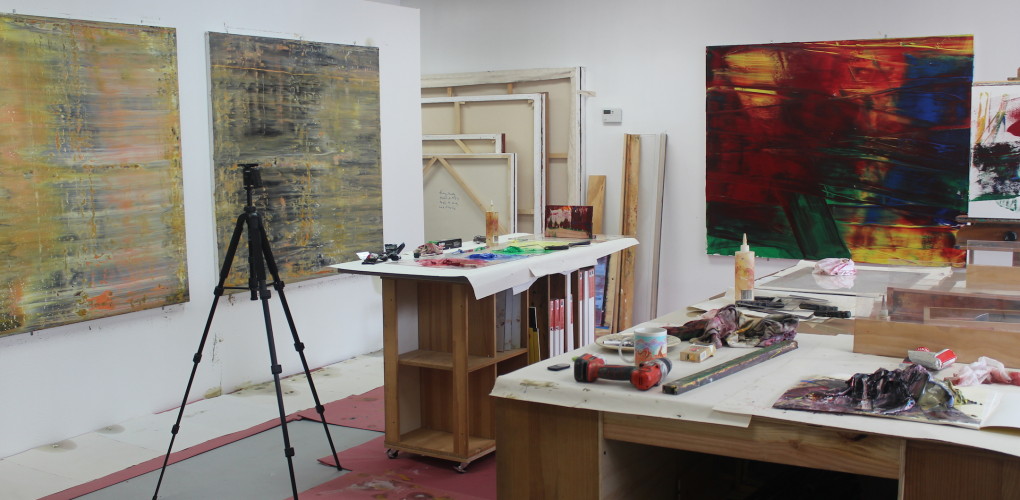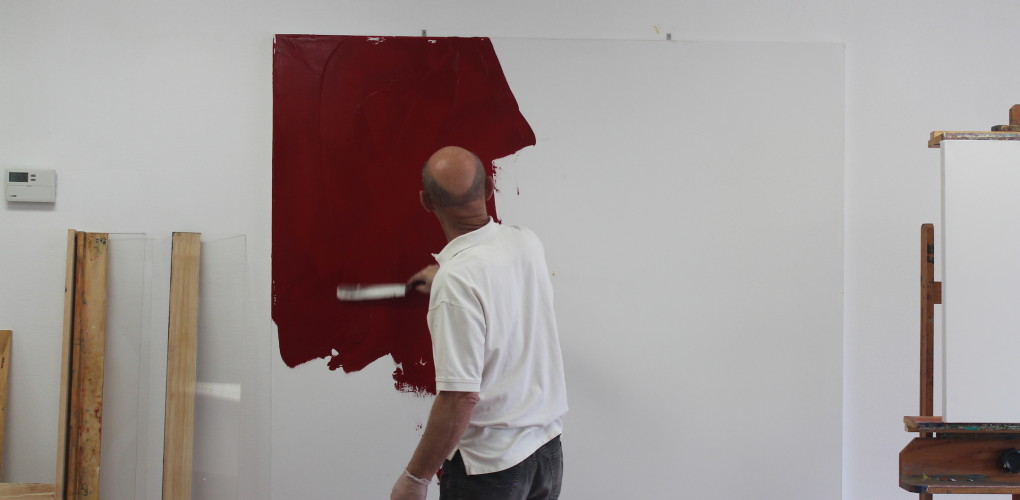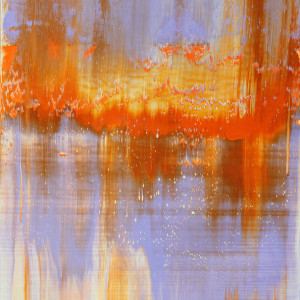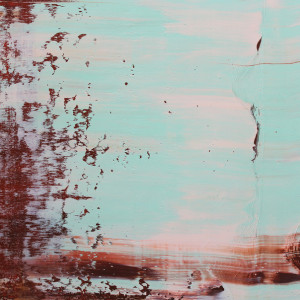Inside the Studio
 Harry Moody
Harry Moody
Favorite material to work with?
Oil. This has many advantages, foremost because no other pigment combination (such as acrylic, tempera, etc.) offers the same luminance or transparency that oil does. Also, I work “wet on wet”. Only oil allows for this. A painting can take days/weeks to finish, so I add clove oil (which can only be mixed with oil paint) in order to keep the painting wet; this slows down the drying process. The down side of this (aside from the fact that it takes a long time to clean up), is that a finished painting can take up to three months before it is “transport” dry. However, I think the results are well worth it. Last but not least, oil ages very well. Just look at an old master or a classic modern. The colors are just as vibrant, if not better, than the day they were painted.
What themes do you pursue?
Currently only one: the abstract—which is not saying I don’t have different bodies of work. Theme? This question somehow reminds me of the obligatory “artist statement,” which is always very difficult for me to write. I mean, if I were able to articulate my thoughts, feelings, and intuitive knowledge in words, then I probably would not have the need to paint and would instead be writing about them. As it is, the painting or the visual experience has been the best way for me to express that which I cannot formulate in words. I will say that for me, abstract best reflects my current curiosity, my search (investigations) and musings over how we see things. As an art student, I was disciplined to translate what my eye sees and not what my mind thinks that it sees. When I look at representational art, I ask myself, “What am I really seeing? What is the reality?” I have realized that I see an illusion of a reality, but not the reality. This illusion is compounded by my normal internal chatter and automated set of associations. Also, I have a language that I use to interpret what I think I see. With abstraction there is no rehearsed language that I can use.
How many years as an artist?
Literally, all of my life. I started drawing obsessively at the age of four. I mean the whole day, sheet after sheet. Then, around the age of 16-17, when one starts to think about what you are going to do with your life, I basically divided the world into two halves, the subjective and the objective: the world of thought, feelings, emotion, and the intangible; versus the world of science, proven fact, or the tangible. I opted for the subjective world and never looked back.
Where is your studio?
My BRAND NEW workshop is located in a small village up in the foothills of Montrose, which is just a few miles north of LA. I like it very much because the mountains are right up in your face and it reminds me very much of my years spent in Lugano, Switzerland.
Art school or self-taught?
Both. I studied formally at the Staedel Art Academy in Frankfurt, Germany. All courses were fundamental and mandatory for the first two years. Students were on their own for the next three years, meaning that all exploring—which was usually through trial and error—was done independently. I am still today teaching myself, which I think is critical for my own growth. If I don’t grow, or am not challenged, then I might as well go mow the lawn. It’s the same difference.
Prefer to work with music or in silence?
I worked ten years in silence. I did not want my sense of reality to be affected by illusions that music might induce. But then I rediscovered classic rock on the radio. I think it was a déjà vu experience for me. I spent my student years in the midst of the music and art revolution during the late 1960s and 70s. I do compare my work sometimes to basic rock and roll: four colors (four chords), and then comes the mixture (rhythm). When I am in a critical work mode, though, it makes no difference. I’m oblivious to everything. It’s just the art and me.
What’s around the corner from your place?
A Chinese restaurant, an Italian pizzeria, an Indian restaurant, a hair salon, and a karate studio. And then there are mountains two or three streets over. I’m still new here, so I haven’t really thought about what to think about my neighbors; but it’s an interesting combination, borderline surreal, considering that I am in the middle of nowhere.
Where can we find you outside of the studio?
Maybe fly fishing somewhere in the middle of the desert, which I didn’t think was possible until a fellow artist colleague told me. I googled it, and sure enough it said one could go fly fishing 45 minutes away from downtown LA. I usually pack my big Canon camera or my smart phone and take photos of nature compositions that I eventually use for my abstracts. It makes no difference if I catch a fish or not. The other place you might find me would be up the street at a local European café that bakes with imported dough from France. Most people would try looking first in the café before venturing off into the desert to find me, or just phone. I will be somewhere.
If you couldn’t be an artist, what would you do?
That has always been my biggest problem. I haven’t been able to do anything else other than art in everything I do. I have tried to get away from art many times. My colleagues and friends, including professors from my Frankfurt Staedel days, would always remind me that I am one of them. This is my roll of the dice. It has been, and still is, a journey with no destination.
Favorite contemporary artist?
I have many favorites, especially here on Saatchi Art. It goes without saying that Gerhard Richter is very high on my list, but so are many other contemporaries. Many artists have influenced me, past and present. Some I have met personally, and others I can only admire from afar. What I like about Saatchi Art is that I get a broad overview of other artists. And, to my pleasant surprise, I often find like-minded colleagues who share the same struggles and aspirations that I do.
What do you collect?
Very little. If anything at all then it would be the nonchalant, the insignificant, the overlooked, the understated, something that has charm, yet is more elusive than obvious.
What was the best advice given to you as an artist?
There has been lots of advice, but the one that sticks out is: “ Inspiration is for amateurs.” Art is work. Of course attitude can either make it fun or a burden. I also like: “Understand your limitations and use them as an asset.” In other words, if you can’t draw a perfect portrait, then stop frustrating yourself. Draw what you can and make it into your own style.
Day job?
It always has been art in one manifestation or the other. I guess it is an understatement to say that it can get bumpy financially; but we all have to do something, and we have to take risks. Art, life, and the uncertainty go hand in hand for me. It has been the uncertainty that creates the dynamic to be inventive and resourceful. It’s also the most trying. The challenge forces me to be motivated and to stay on my toes.
Is painting dead?
This is a fun and loaded question. According to Duchamp, (and quoting Gerhard Richter), the answer would be “yes.” From my point of view, this holds some truth. I think this has more to do with the fact that the definition of “art” has expanded explosively into many different mediums and technologies. This literally creates a constant demand for something “new.” Who remembers the ordinary, until the special becomes ordinary, and thus the cycle continues. I find it amazing when I look around and I see “paint” being integrated everywhere into our daily lives; I get the feeling that it is all taken for granted. Streets are painted with symbols and lines; houses, the walls in our rooms, cars, advertisement packaging, textiles, clothes, toys—these all use color (alias paint). It is all the same pigment. For me, the reality is that the possibilities in painting remain infinite. Just picking up and following the footsteps where another artist (i.e. Paul Klee) left off would be a lifetime job.
Favorite brush?
Short of my fingers, I use many tools to apply paint. Some of my brushes are 15 -20 years old. I also have an array of palette knifes, probably every size, form, and shape that are available on the market. I also use masonry trowels and self-made squeegees. I apply large quantities of paint manually onto the surface. The quickest and most even method that I have found is using a trowel or a squeegee. Once the paint is on the canvas, though, it is a whole different arena. Then all tools come into question.


















